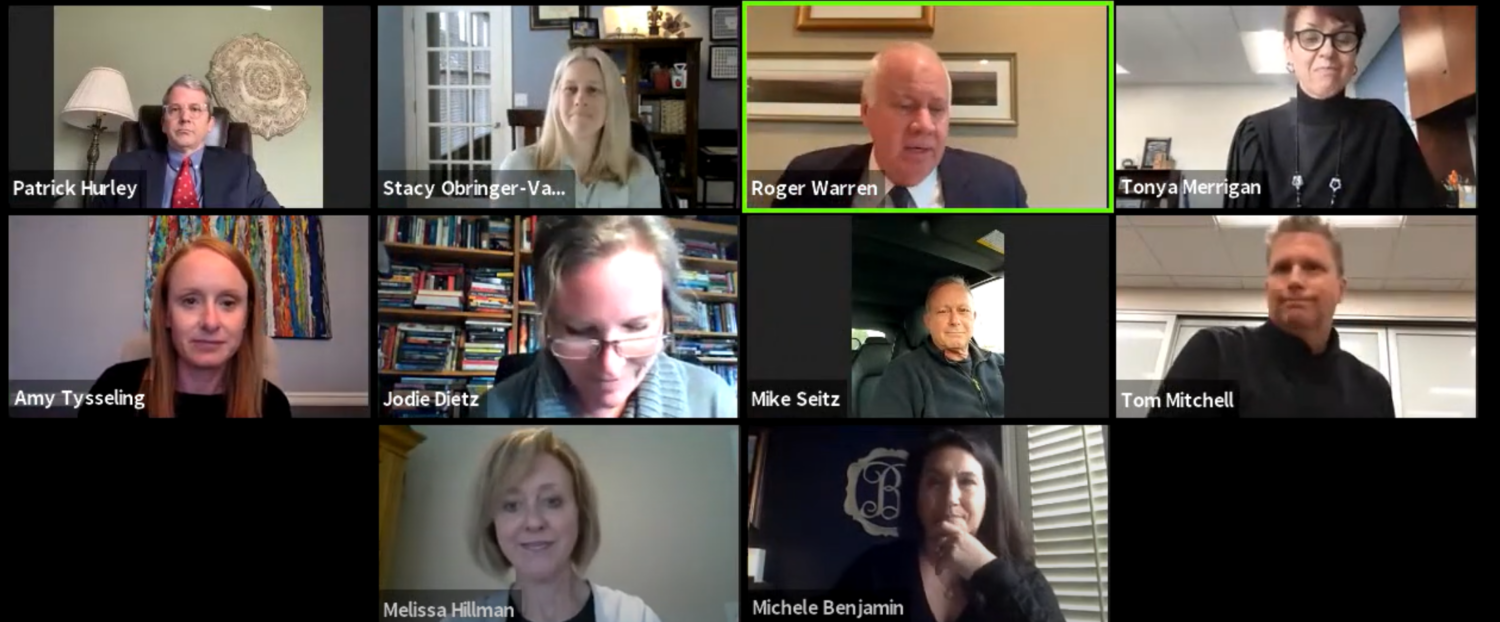A University of Kansas researcher last week told the Lawrence Journal-World that counties with mask mandates have far less case COVID case growth than the rest of the state, but the Sentinel’s review of the data shows just the opposite – cases have grown more than twice as fast in counties with mask mandates since the end of June. The timing of the misleading claim, as explained later, may not be a coincidence.
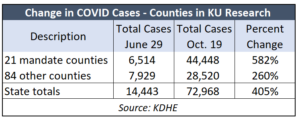 Between June 29 and October 19, the counties that the KU researchers include as having mask mandates went from having 6,514 cases to 44,448 cases, for an increase of 582%. The other counties had a 260% increase, going from 7,929 to 28,520.
Between June 29 and October 19, the counties that the KU researchers include as having mask mandates went from having 6,514 cases to 44,448 cases, for an increase of 582%. The other counties had a 260% increase, going from 7,929 to 28,520.
The project conducted by the KU Institute for Policy and Research didn’t mention total case growth and their report doesn’t show the total number of cases. Instead, they compared changes in the 7-day rolling average of new cases per day. That approach obscures total case growth because it doesn’t show the compounding effect of daily changes.
Change in growth rates vs. total change
The KU analysis counts 21 counties as having mask mandates, shown in solid blue on their map. They don’t include the four counties they say have mandates but aren’t enforcing them – Crawford, Grant, Mitchell, and Montgomery.
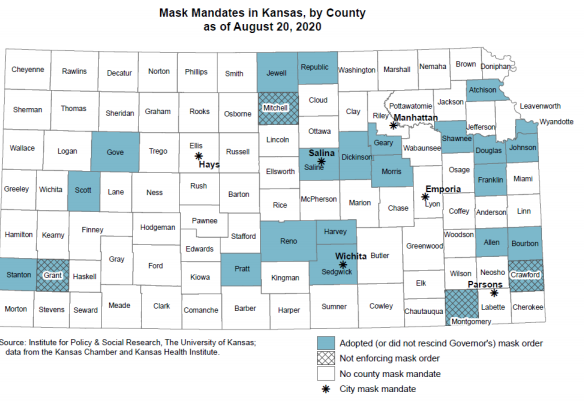
Their county case data is sourced to the New York Times but not shown in their report, so we used case data from the Kansas Department of Health and Environment in the charts below.
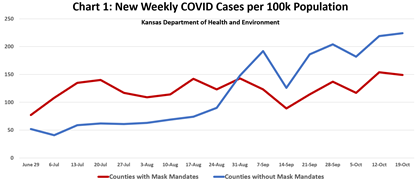 Chart 1 uses the presentation option chosen by the KU researchers, tracking the number of new cases per week per 100,000 population. (They used a 7-day rolling average, whereas this presentation smoothes the data to show weekly change). The chart begins on June 29, which is a few days before the governor’s mask mandate went into effect. It gives the impression that cases are growing much more rapidly in the counties that rejected Governor Kelly’s mask mandate.
Chart 1 uses the presentation option chosen by the KU researchers, tracking the number of new cases per week per 100,000 population. (They used a 7-day rolling average, whereas this presentation smoothes the data to show weekly change). The chart begins on June 29, which is a few days before the governor’s mask mandate went into effect. It gives the impression that cases are growing much more rapidly in the counties that rejected Governor Kelly’s mask mandate.
 Another way of tracking the weekly change is shown in Chart 2. It’s based on the same data as in Chart 1 but shown cumulatively. Both charts show that cases grew faster in mandate counties through the end of August, and while the narrowing of the gap shows that cases have grown faster in the other counties since then, the mandated counties still have more cumulative new weekly cases.
Another way of tracking the weekly change is shown in Chart 2. It’s based on the same data as in Chart 1 but shown cumulatively. Both charts show that cases grew faster in mandate counties through the end of August, and while the narrowing of the gap shows that cases have grown faster in the other counties since then, the mandated counties still have more cumulative new weekly cases.
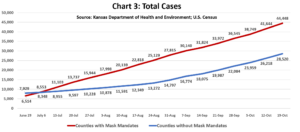 Chart 3 tracks the data showing total cases for each group over time. As stated earlier, the counties with mask mandates experienced a 582% increase in cases, to 44,448; the increase in the other group of counties is 260%, to 28,520.
Chart 3 tracks the data showing total cases for each group over time. As stated earlier, the counties with mask mandates experienced a 582% increase in cases, to 44,448; the increase in the other group of counties is 260%, to 28,520.
All three charts are based on the same data, but only the presentation used by the KU researchers makes it appear that counties with mask mandates have much less growth in COVID cases.
This begs the question of motivation.
Lead researcher is a Kelly advisor
It may not be a coincidence that the KU researchers released their findings a few days after Governor Kelly announced she wants legislators to strip cities and counties of their authority to reject her orders so she can implement a statewide mask mandate.
The lead researcher on the KU study, Donna Ginther, is a Laura Kelly confidant. Kelly’s tax commission, which some people believe is designed to give her cover to propose tax increases next year, engaged Ginther “to perform tax policy analysis, tax incidence studies and other research as directed by the Council.” Kelly stacked her tax council with members predisposed to promote tax increases, like left-leaning former legislators and city and county officials; taxpayer-focused policy experts, business leaders, and center-right economists were excluded from the tax council.
KDHE Secretary Lee Norman’s deceptive attempt to justify mask mandates was exposed by the Sentinel and the Wall Street Journal, so Kelly may want new research to wield over legislators. Enter Ginther and the KU Institute for Policy and Research.
Ginther’s methodology questioned
This isn’t the first time that Ginther’s findings have been called into question.
Laura Kelly often referenced Ginther’s research attempting to connect welfare reforms enacted by the Brownback administration with child maltreatment when she was running for office. The Kansas Department for Children and Families had for months disputed the conclusions of the researchers and two weeks before Kelly was to take office, DCF released a report challenging the KU research.
DCF commissioned University of Maryland professor and renowned child welfare researcher Douglas Besharov and Neal Gilbert, professor of Social Welfare and Social Service at the University of California at Berkeley, to examine Ginther’s research.
In an interview with The Imprint, Besharov said, “You want the best possible evidence to shape the policy changes you might make.” He went on to say, “The publication we were asked to review doesn’t meet that standard.”
The article continues.
“In the evaluation, Besharov and research partners criticize the use of incomplete data and analysis, incomplete and shifting variables concerning TANF and other program changes, other changes in child welfare policy and practices that are not considered, increases in opioid and other substance use during the time frame, and even the interpretation of the results by the authors.”
The link provided to the DCF report in The Imprint article is no longer functional, indicating the report may have removed by the Kelly administration.
Economist Michael Austin, director of the Center for Entrepreneurial Government at Kansas Policy Institute, which owns the Sentinel, expressed concerns with Ginther’s conclusions on the efficacy of mask mandates.
“Ginther and her partner did what’s called a “difference in difference” analysis, meaning they based their analysis on an assumption no Kansans wore a mask before Kelly’s mandate order and 100% of Kansans wore a mask afterward. They have shown no hard data on other critical aspects needed to form an opinion. For example, how diligently did people wear masks in each county, regardless of whether a mandate was in effect? They also ignore other variables that directly impact case growth, including comparative testing levels and population density.”
Austin also notes that an unknown number of cases are likely ‘false positives,’ because the state lab and many private labs have cycle thresholds set so high that non-contagious COVID particles can be detected. Variances in those numbers across counties could be another important factor that would skew the data.
Despite basing their assumptions on incomplete data and variables, Austin says the case numbers invalidate their conclusion.
“The inescapable fact remains that counties with mask mandates have experienced 582% case growth since June 29, while cases only increased 260% elsewhere.”



